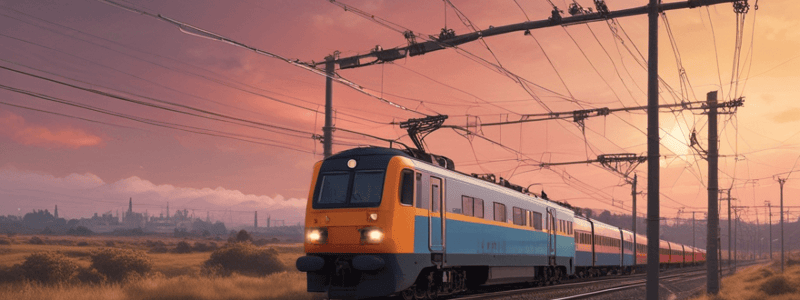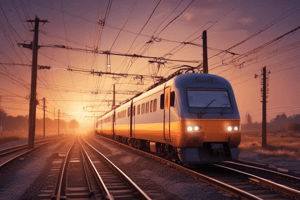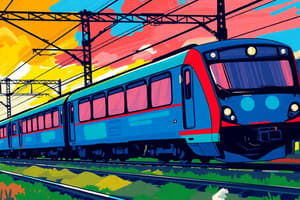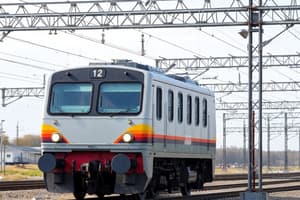Podcast
Questions and Answers
What is the minimum ballast resistance required in a station yard?
What is the minimum ballast resistance required in a station yard?
- 1 ohm per km
- 2 ohms per km (correct)
- 4 ohms per km
- 3 ohms per km
Who should be informed of defective valves of overhead water pipes in track circuited areas?
Who should be informed of defective valves of overhead water pipes in track circuited areas?
- SSE(JE-P-Way)
- Sectional SSE/JE(Signal)
- SSE(Signal)
- Inspector of Works SSE/JE(Works) (correct)
How often should jumper connections be inspected and maintained?
How often should jumper connections be inspected and maintained?
- Daily
- Weekly
- Frequently (correct)
- Monthly
What is the purpose of taking voltage readings at every 15 rail lengths or less?
What is the purpose of taking voltage readings at every 15 rail lengths or less?
What should be done to bonds where corrosion is excessive?
What should be done to bonds where corrosion is excessive?
What is the minimum level of insulated liners required with PSC Sleepers?
What is the minimum level of insulated liners required with PSC Sleepers?
How often should the track circuited portion of the track be jointly inspected?
How often should the track circuited portion of the track be jointly inspected?
What should be done to defective insulation on stretcher bars and point rodding?
What should be done to defective insulation on stretcher bars and point rodding?
Who is responsible for the installation and maintenance of rail joint bonds?
Who is responsible for the installation and maintenance of rail joint bonds?
What is the minimum distance required for longitudinal bonding on a non-track circuited track adjacent to a track circuit?
What is the minimum distance required for longitudinal bonding on a non-track circuited track adjacent to a track circuit?
What is the purpose of rail bonds and cross bonds?
What is the purpose of rail bonds and cross bonds?
Who is responsible for the maintenance of traction bonds?
Who is responsible for the maintenance of traction bonds?
What is the frequency of physical inspection of traction return and track circuit bonding?
What is the frequency of physical inspection of traction return and track circuit bonding?
What happens in the event of faulty connection or bond being found during inspection?
What happens in the event of faulty connection or bond being found during inspection?
Where can detailed instructions for bonding of track be found?
Where can detailed instructions for bonding of track be found?
What is the purpose of bonding the two rails of the non-track circuited track outside any track circuit or in between two track circuits?
What is the purpose of bonding the two rails of the non-track circuited track outside any track circuit or in between two track circuits?
What is the minimum cross section of galvanized iron wire for short jumpers?
What is the minimum cross section of galvanized iron wire for short jumpers?
What is the minimum size of cables for long jumpers?
What is the minimum size of cables for long jumpers?
What is the purpose of using bond wire clips?
What is the purpose of using bond wire clips?
What is the maximum allowed resistance of rail and bonding per 1000 meters of track for track circuits longer than 700 meters?
What is the maximum allowed resistance of rail and bonding per 1000 meters of track for track circuits longer than 700 meters?
What is the purpose of using a twist drill to drill bond holes?
What is the purpose of using a twist drill to drill bond holes?
What is the recommended material for lead wires connecting the feed set to the feed end boot leg/track lead Junction Box?
What is the recommended material for lead wires connecting the feed set to the feed end boot leg/track lead Junction Box?
Why is it important to keep the Track lead Junction Box clear of ballast?
Why is it important to keep the Track lead Junction Box clear of ballast?
What is the purpose of paralleling the +ve and -ve leads at each end?
What is the purpose of paralleling the +ve and -ve leads at each end?
What is the maximum amount of current that an AC impedance bond can support without damage or overheating?
What is the maximum amount of current that an AC impedance bond can support without damage or overheating?
What type of cables should be used for leads between impedance bonds across IRJ on the same track?
What type of cables should be used for leads between impedance bonds across IRJ on the same track?
Who is responsible for the provision and maintenance of connections between rail and impedance bonds?
Who is responsible for the provision and maintenance of connections between rail and impedance bonds?
Where should cross bonds, earth wires, and connections to sub-station current return busbars be terminated?
Where should cross bonds, earth wires, and connections to sub-station current return busbars be terminated?
What is the most important factor to consider during the installation and maintenance of track circuits in RE area?
What is the most important factor to consider during the installation and maintenance of track circuits in RE area?
What is the primary responsibility of the electrical department in relation to impedance bonds?
What is the primary responsibility of the electrical department in relation to impedance bonds?
What is the purpose of impedance bonds in the track circuit?
What is the purpose of impedance bonds in the track circuit?
What guidelines should be followed for the installation and maintenance of track circuits in RE area?
What guidelines should be followed for the installation and maintenance of track circuits in RE area?
What is the primary goal of maintaining a high ballast resistance in track circuits?
What is the primary goal of maintaining a high ballast resistance in track circuits?
What should be done to ensure the track circuit is properly energized during wet weather?
What should be done to ensure the track circuit is properly energized during wet weather?
What is the recommended frequency for inspecting and maintaining jumper connections?
What is the recommended frequency for inspecting and maintaining jumper connections?
What is the primary purpose of insulating joints in track circuits?
What is the primary purpose of insulating joints in track circuits?
What should be done to bonds where corrosion is excessive?
What should be done to bonds where corrosion is excessive?
Why is it essential to maintain a good connection between power feed and track?
Why is it essential to maintain a good connection between power feed and track?
What is the primary goal of maintaining a high limiting resistance in track circuits?
What is the primary goal of maintaining a high limiting resistance in track circuits?
What should be done to prevent permanent magnetization of DC track relays?
What should be done to prevent permanent magnetization of DC track relays?
Who verifies the clearance of the block section with the on-duty Assistant Station Master of the receiving station?
Who verifies the clearance of the block section with the on-duty Assistant Station Master of the receiving station?
What is the purpose of exchanging private numbers between the dispatching and receiving stations?
What is the purpose of exchanging private numbers between the dispatching and receiving stations?
What is the purpose of the reset box being operated by a key?
What is the purpose of the reset box being operated by a key?
What is shown on the panel diagram when a portion of the track circuited area is occupied?
What is shown on the panel diagram when a portion of the track circuited area is occupied?
What type of track relays should be used in future installations?
What type of track relays should be used in future installations?
What is the purpose of recording the reset operation in the Train Signal Register?
What is the purpose of recording the reset operation in the Train Signal Register?
What is the role of the Signal and Traffic Inspecting officials during station inspections?
What is the role of the Signal and Traffic Inspecting officials during station inspections?
What is the minimum percentage of the rated pick-up voltage required to excite a DC track relay?
What is the minimum percentage of the rated pick-up voltage required to excite a DC track relay?
What is the purpose of laying down the procedure of resetting in Station Working Rules?
What is the purpose of laying down the procedure of resetting in Station Working Rules?
What is the maximum allowed excitation voltage for QBAT relays?
What is the maximum allowed excitation voltage for QBAT relays?
What is the purpose of individual indications of each track circuit on the panel?
What is the purpose of individual indications of each track circuit on the panel?
What is the purpose of piloting the first train after resetting the axle counter?
What is the purpose of piloting the first train after resetting the axle counter?
What is the significance of the non-resettable type counter in the reset box?
What is the significance of the non-resettable type counter in the reset box?
What is the indication shown on the panel when the line is unoccupied at other stations?
What is the indication shown on the panel when the line is unoccupied at other stations?
What is the purpose of adjustable limiting resistance in DC track circuits?
What is the purpose of adjustable limiting resistance in DC track circuits?
What is the maximum length of a track circuit under different track parameter conditions?
What is the maximum length of a track circuit under different track parameter conditions?
What action should be taken if an end-post projects above the rail at the ends?
What action should be taken if an end-post projects above the rail at the ends?
What should be done to a fish bolt if the rail hole and fishplate holes are in their proper position and alignment?
What should be done to a fish bolt if the rail hole and fishplate holes are in their proper position and alignment?
What should be used in the glued joint portion of the track?
What should be used in the glued joint portion of the track?
At track-circuited stations where track indicators are provided, what would normally be shown on the track indicator?
At track-circuited stations where track indicators are provided, what would normally be shown on the track indicator?
What should be done to the insulated Rail Block Joint or Device of Axle Counter or Joint Less Track Circuit?
What should be done to the insulated Rail Block Joint or Device of Axle Counter or Joint Less Track Circuit?
What should be done to the insulation joint in point track circuits?
What should be done to the insulation joint in point track circuits?
What would happen to the track indicator light if action is initiated to set the route for taking off a signal and the concerned route is set?
What would happen to the track indicator light if action is initiated to set the route for taking off a signal and the concerned route is set?
What is the minimum distance required between the insulated Block Joint or Detection Point and the starter signal for signaled movements?
What is the minimum distance required between the insulated Block Joint or Detection Point and the starter signal for signaled movements?
What is the main objective of checking the insulation of stretcher bars and point rodding?
What is the main objective of checking the insulation of stretcher bars and point rodding?
How often should voltage readings be taken to detect defective bonding?
How often should voltage readings be taken to detect defective bonding?
What is the minimum ballast resistance required in a block section?
What is the minimum ballast resistance required in a block section?
Who should jointly inspect the track circuited portion of the track?
Who should jointly inspect the track circuited portion of the track?
What should be reported to the Inspector of works SSE/JE(Works) during rains?
What should be reported to the Inspector of works SSE/JE(Works) during rains?
What should be done to defective insulation on stretcher bars and point rodding?
What should be done to defective insulation on stretcher bars and point rodding?
What is the minimum level of insulated liners required with PSC Sleepers?
What is the minimum level of insulated liners required with PSC Sleepers?
Why is special attention paid to track drainage during rains?
Why is special attention paid to track drainage during rains?
What is the maximum allowed voltage drop in lead connections to and from battery and DC-DC converter?
What is the maximum allowed voltage drop in lead connections to and from battery and DC-DC converter?
How should connections between battery, battery charger, and DC-DC converter be laid?
How should connections between battery, battery charger, and DC-DC converter be laid?
What is the recommended minimum distance between quad cables or PIJF Telecom Cables and other bunches of wires?
What is the recommended minimum distance between quad cables or PIJF Telecom Cables and other bunches of wires?
What is the purpose of providing redundancy in train detection devices?
What is the purpose of providing redundancy in train detection devices?
Who should reset the axle counter in case of a fault condition?
Who should reset the axle counter in case of a fault condition?
What is the purpose of twin twisting positive and negative wires?
What is the purpose of twin twisting positive and negative wires?
Where should power for axle counter be taken from in Integrated power supplies?
Where should power for axle counter be taken from in Integrated power supplies?
What should be done to connections between battery, battery charger, and DC-DC converter to ensure reliable operation?
What should be done to connections between battery, battery charger, and DC-DC converter to ensure reliable operation?
Flashcards are hidden until you start studying
Study Notes
Connection and Bonding
- Connections shall be firmly fitted to the web of the rail.
- Galvanized iron wires or cables may be used for short or long jumpers, respectively.
- The cross-section of galvanized iron wire shall not be less than 8 SWG, and cables shall not be smaller than 7/0.750 mm.
- Lead wires used for connecting feed sets to feed end boot leg/track lead Junction Box (JB) and track relay to relay end boot leg/track lead JB shall preferably be of copper conductor with a minimum cross-section of 2.5 sq.mm.
Bond Wires and Rope Wires
- Bond wires/rope wires shall be of an approved type, with duplicate wires installed close to the fish plate.
- Bond holes shall be drilled with a twist drill, and bonds driven in immediately.
- The resistance of rail and bonding per 1000 meters of track shall not exceed 0.5 ohms for track circuits longer than 700 meters.
- Rail bonding and connections to the relay and feed set shall be made according to approved drawings.
Types of Bonds in RE Area
- Rail Joint Bonds: Two 8 SWG bare galvanized steel wires or copper bonds/steel wires or flats secured by means of channel pins or welding/riveting.
- Rail bonds and Cross bonds: Installed by and remain the responsibility of the electrical department.
- Longitudinal bonding on a non-track circuited track adjacent to a track circuit shall be extended for a distance of 50 meters beyond the track circuit.
- The two rails of the non-track circuited track outside any track circuit or in between two track circuits shall be bonded together immediately after the block joints.
Maintenance
- The SSE/JE (Traction) and SSE/JE (Signal) of section shall arrange for physical inspection at six-month intervals to ensure conformity with approved Bonding Plan.
- In the event of faulty connection or bond being found, immediate remedial action will be taken to restore system integrity.
Stretcher Bars and Point Rodding Connections
- Insulation for stretcher bars and point rodding shall be periodically checked to ensure they are in sound condition.
- All defective insulation shall be changed.
Bond Wires/Rope Wires
- Bonds shall be inspected frequently and maintained in good condition.
- Bonds shall be painted with aluminum paint, where bond corrosion is excessive.
- Voltage reading may be taken at every 15 rail lengths or less as required by special track circuits to determine if the variation in voltage is gradual throughout the track circuit.
Jumper Connections
- Jumper connections shall be inspected frequently and maintained in good condition.
- Long jumper connections shall be properly secured.
Ballast
- Minimum ballast resistance of track should not be less than 2 ohms per km in station yards and 4 ohms per km in block sections.
Drainage
- Special attention shall be paid during the rains to track drainage.
- Defects, if any, shall be reported to the SSE/JE(P-Way).
Joint Inspection of Track
- The track circuited portion of the track shall be jointly inspected by SSE (Signal)/incharge and SSE(P-way)/incharge and jointly by Sectional SSE/JE (Signal) & SSE/JE (P-way) at least once in six months.
Hammer Driving and Rail Hole Alignment
- Hammer driving offish-bolt should be avoided to prevent damage to nylon bushes.
- Fish bolt can be easily inserted by hand pressure if the rail hole and fishplate holes are in proper position and alignment.
End-Post Trimming
- End-post should be trimmed and brought to the level of the rail table, especially when inserted between worn-out rails, before the first wheel of a train passes over it.
Insulated Block Joint and Detection Point
- The distance of 13 meters between the Insulated Block Joint or Detection Point and the starter signal can be reduced to 3 meters for signaled movements.
- The insulated Rail Block Joint or Device of Axle Counter or Joint Less Track Circuit should be fixed so that their boundary is within 0 to 3 meters in advance of the starter signal.
Point Track Circuits
- Insulation joint should not be in the stock rail joint but in the rail joint ahead of it wherever feasible.
Glued Joint Portions of Track
- Only 'J' type clip should be used in glued joint portions of track.
Track Indicators
- At track-circuited stations where track indicators are provided, the track indicators would show no light when the line is unoccupied.
- When the line is unoccupied, the track indicator light for the route shows yellow/white.
- When the track is occupied, a "RED" indication is shown on the panel diagram, irrespective of the route being set or not.
- At panel interlocked/route relay interlocked stations, the track indicators would show white/yellow light when the track is cleared after the intended movement is completed.
- At other stations, the indicator shall show yellow/white light when the line is unoccupied and RED when the line is occupied.
Axle Counter Resetting
- Preparatory reset arrangement should be provided, so that whenever the axle counter shows fault condition, the same can be reset by the on-duty Assistant Station Master/Station Master.
- The on-duty Assistant Station Master/Station Master should positively verify the clearance of the block section with the on-duty Assistant Station Master of the Train receiving station by exchanging private numbers and recording the same in the Train Signal Register.
Track Circuits and Axle Counters
- The maximum length of track circuit under different track parameter conditions shall not exceed the limits as given in the specified table.
- Limiting resistance of DC track circuits shall be adjustable and of an approved type.
Track Relays
- DC track relays of approved design should be used.
- In future installations, only plug-in type track relays (9 ohm) should be used, both in Non-RE and RE areas.
- Q series track relay must be used in conjunction with Q series slow to pick-up relay as a repeater relay.
- Excitation of DC Track Relay should be at minimum 125% of its rated pick-up voltage under minimum ballast resistance condition and normal working voltage of the supply.
Stretcher Bars and Point Rodding Connections
- Insulation for stretcher bars and point rodding should be periodically checked to ensure they are in sound condition.
- All defective insulation should be changed.
Bond Wires/Rope Wires
- Bonds should be inspected frequently and maintained in good condition.
- Bonds should be painted with aluminum paint where bond corrosions are excessive.
- Voltage reading may be taken at every 15 rail lengths or less as required by special track circuits, to determine if the variation in voltage is gradual throughout the track circuit.
Jumper Connections
- Jumper connections should be inspected frequently and maintained in good condition.
- Long jumper connections should be properly secured.
Ballast
- Minimum ballast resistance of track should not be less than 2 ohms per km in station yard and 4 ohms per km in the block section.
Drainage
- Special attention should be paid during the rains to track drainage.
- Defects, if any, should be reported to the SSE/JE(P-Way).
- All cases of defective valves of overhead water pipes in track-circuited area should be reported to the Inspector of works SSE/JE(Works).
Joint Inspection of Track
- The track-circuited portion of the track should be jointly inspected by SSE (Signal)/incharge and SSE(P-way)/incharge and jointly by Sectional SSE/JE (Signal) & SSE/JE (P-way) at least once in six months.
Power Supply and Cabling
- All lead connections to and from battery and DC-DC converter should have adequate current capacity to ensure that the voltage drop does not exceed 0.2 V.
- These connections at terminals should be secured properly and should preferably be made through lugs to give firm contact.
- Connections between battery, battery charger, and DC-DC converter should not be bunched with any other wires.
- These wires should preferably be laid at least 150 mm from any other bunch of wires.
- Positive and negative wires should be twin twisted to avoid interference pick up especially when the lead wires are long.
Communication Media
- The quad cable or PIJF Telecom Cable used with axle counters should be of approved type.
- The transmission loss, cross-talk measurements should be within limits specified for the axle counter to be installed.
- Optical Fibre Cable (OFC) may also be used for communication with suitable interfaces.
- All precautions prescribed for laying and installation of communication cables should be strictly followed.
Studying That Suits You
Use AI to generate personalized quizzes and flashcards to suit your learning preferences.




